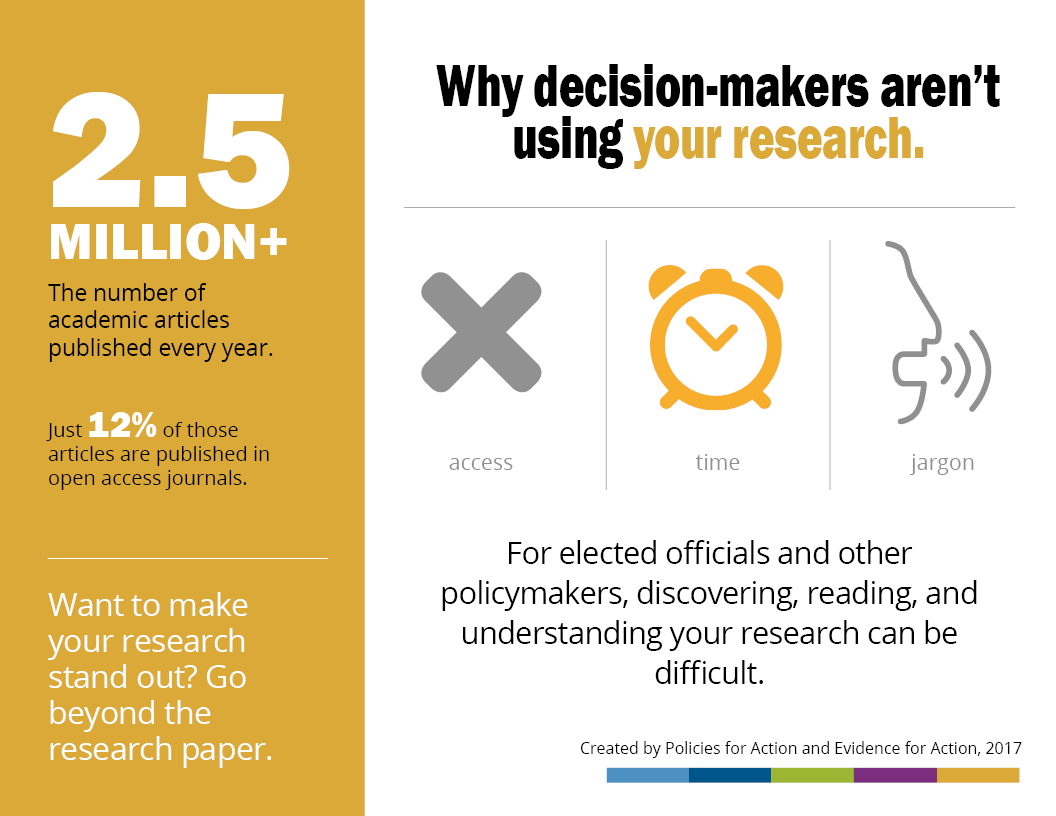Turning research into action: A dialogue with decision-makers (PART ONE)
|
Multivariate analysis. Face validity. Sampling bias. For researchers, these are everyday terms. For policymakers, advocates, and other stakeholders, they might as well be ancient Sumerian.
A lack of a shared language is one barrier to turning research into action, but it’s not the only one. A few weeks ago, we sat down with a group of local decision-makers to find out how we, as researchers, can more effectively ensure that our research contributes to real-world improvements in population health, well-being, and equity.
Show me the money… and time and staff
In our conversation, we weren’t surprised to hear that the budget is often the first—and largest—hurdle a policymaker must face when implementing evidence-based policy. If the funding is not there or the return on investment is unclear, the policy in question will likely fall flat.
Time constraints and limited bandwidth also get in the way. In small states, legislators are virtually on their own, with few or no staff to help track down relevant data. Additionally, online academic journals often come with paywalls and paid subscriptions, meaning that the necessary research is just out of reach.
As one decision-maker put it, “If your research is in a journal, I can’t get to it.”

Facts matter, but so do values and principles
Our decision-makers also spoke candidly about the framing challenges they face translating research into action.
Elected officials and other policymakers must tread carefully, balancing the needs of their constituency with the values of that constituency. No matter what, evidence doesn’t exist in a vacuum—partisanship, ideology, and belief systems matter too. One decision-maker characterized it like this:
“Most people know the evidence against smoking. But they may also harbor an ideology that government shouldn’t tell people what to do in their personal lives. There’s a significant challenge in explaining your evidence in light of these overarching lenses.”
Researchers who want to see their work bear fruit in a policy environment must understand these ideological contexts. If a policymaker has invited you to speak about your research, be sure you know what kind of environment they are navigating. Do local leaders embrace skin-in-the-game, market-driven policies, or are they looking to make a publicly funded means-tested program more effective? Or perhaps a decision-maker sees the value in a policy or practice change, but needs help making the case to other leaders in the community? Try to communicate your findings in a manner that avoids the traps of dueling ideologies. And remember, even researchers aren’t immune from ideological biases.
Asking the right questions, together
Throughout the conversation, our decision-makers underscored that well-intentioned people want to use evidence as the cornerstone of policy, but often struggle to find research that corresponds to their needs.
For example, one of our decision-makers is a coordinator at a middle school youth services center, which helps students thrive by promoting early learning, academic achievement, and overall well-being. The program looks and feels like a success, but the school has few ways of reliably demonstrating its impact: the only outcome measure they have is test scores.
For this program’s leaders, a proactive dialogue with researchers might stimulate a new kind of research agenda, where additional outcomes are tracked and measured. Greater collaboration on both research and practice could lend more credibility to the program, reveal areas for improvement, and help sustain or scale it.
Walking a mile…
As researchers interested in informing policy, it is important to understand the challenges that decision-makers face in translating research into evidence-based policy—from the practical to the ideological. In Part Two, we’ll delve into concrete ways of translating your research into a format that resonates with busy, overextended policymakers. That process starts with four questions…
We are enormously grateful to Debra Miller (The Council of State Governments), Tom Walton (KentuckyOne Health), John Gribbins (Noe Middle School), and Rebecca Hollenbach (Louisville Center for Health Equity), for their insights and guidance.
Photo by wellphoto/Shutterstock
Related Projects
-
September 28, 2016
|Has Evidence
| -
October 21, 2016
|Has Evidence
|